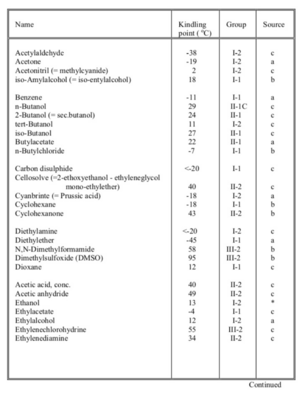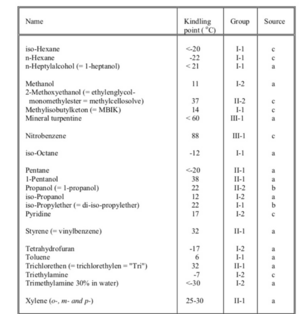Flammable liquids
- Liquid: Substance that is fluid at normal temperatures and pressure.
- Kindling point: The lowest temperature at which a liquid emits flammable vapors.
- Flammable liquid: Liquid with kindling point below 100 °C.
- Class I: Flammable liquid with kindling point below 21 °C.
- Class II: Flammable liquid with kindling point of 21-55 °C.
- Class III: Flammable liquid with kindling point above 55-100 °C.
All 3 classes are classified in subclass 1 for not water miscible and subclass 2 for liquids that are water miscible under all conditions
Class | Storage amounts | Max. storage in | |
Glass | Approved plastic or metal container | ||
I II III |
1 L 5 L 50 L |
2.5 L 5 L 10 L |
no restrictions up to 25 L no restrictions up to 125 L no restrictions up to 1250 L |
Plastic packaging over 125 ml must always approved by the Danish Emergency Management Agency (”Beredskabsstyrelsen”).
The given amounts refer to the total amount of stock, usage and waste.
Altogether, there should be no more than 50 storage units per laboratory
Containers with inflammable liquids of Class I-1, I-2, II-1 and III-1 must not be placed in any of the escape routes (corridors, stairways, etc.).
Flammable and explosive chemicals
Avoid working near open flames or where there is a risk of sparks.
NB: Explosive substances eg. diethyl ether and petroleum ether should not be stored in a normal refrigerator.
The information given in this section comes from the following sources:
- Kemikalier og Sikkerhed, Teknisk Forlag, 1976.
- Merck Index, 11th edition, 1989
- Hommel's Handbuch der gefährlichen Güter, 1973/74.
See also the KIROS database (https://www.kiros.dk/Web/)

